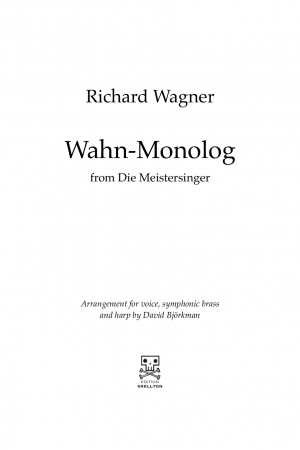“But at a cathedral, that doesn’t fit in at all. That’s remarkable!” Composer Niels W. Gade gasped when he met Elfrida Andrée. She was the organist at Gothenburg Cathedral, and the first female cathedral organist in all of Europe. Becoming Europe’s first female cathedral organist was not easy for composer Elfrida Andrée, and when she heard that she had won the audition she fainted. She had undergone quite a struggle to reach this position. Simply learning to play the organ had been a challenge. The young Elfrida Andrée from the town of Visby therefore passed her organ examination as an external candidate, and was the first woman in Sweden to do so. She had no prospects of employment. A woman at the organ would lead to turmoil and distraction during services. And in his first letter to the Corinthians, St Paul himself had said “let your women keep silence in the churches”. Andrée resolved there and then to rebel against St Paul.
Instead of waiting for a divine answer, she decided to write a letter. She wrote to the King in Council asking for the country’s laws to be changed, and ten years later she sat at the organ stool in Gothenburg Cathedral. She would also teach a number of organists herself, encouraging women in particular to learn. She passed on the fruits of her pioneering efforts to the next generation, and made a real difference: Suddenly, all but two of the organists in the Gothenburg area were women. The churches were now full of distracting women, and they all played the organ.
Only one instrument was greater than the organ: the symphony orchestra. And just as with the church organ, her orchestral debut was not without friction. Andrée’s Symphony No. 1 in C Major was performed in 1869 at the Hammar Theatre in Stockholm, and naturally the composer herself was present. But something didn’t sound right, and it gradually dawned on her: The musicians were playing wrong notes on purpose! Eventually, she stood up mid-performance and walked out. Andrée stayed in bed for three days, while newspapers wrote about a deformed symphony and her anxious family suggested that she might like to stick to chamber music, and perhaps slightly lighter, shorter pieces.
However, she had her own motto: The elevation of the female species. This involved enhancing women’s status and opportunities, and guided her work throughout her life. Andrée continued to compose. She also conducted, taught and played at concerts and church services. And there soon came another symphony, and another – for organ and woodwind – and several more orchestral works, as well as a full-evening opera.
The opera was called Fritiofs Saga, with a libretto by the Swedish writer Selma Lagerlöf. With its Wagnerian influences and its late Romantic style, it was com- posed as a competition entry for the opening of Stockholm’s new opera house in 1898. However, the only contemporary performance of the opera was by amateur musicians from Gothenburg. It then lay forgotten until the Gothenburg Opera and conductor Marit Strindlund woke the opera from its slumbers in 2019. When Andrée was born, Swedish women had hardly any rights. By the time of her death in 1929, women had been able to vote since 1921. At that stage, Andrée was on leave from Gothenburg Cathedral, but she went there in the evenings anyway and played the organ late into the night. One night, she pulled out all the stops and the sound of the mighty organ thundered through the huge cathedral. As the final chord faded away, she called out: “That showed you, little St Paul!”
About the 2021 Swedish Wind Ensemble recording project and collaboration between arranger the Swedish Wind Ensemble, Anders Högstedt and Edition Skellton:
“The Swedish Wind Ensemble recorded these works in the same year that Sweden marked the centenary of women’s voting rights. The recording took place at the Musikaliska concert hall in the heart of Stockholm. The Royal Swedish Academy of Music has convened here for a number of musical and historical events over the years, including the presentation of the first Nobel Prize in 1901. The venue also
saw the first Swedish performance of Helena Munktell’s work Breaking Waves, during the Academy’s formal gathering. She, Elfrida Andrée and Clara Schumann were all members of the Academy. Today, Musikaliska is the home of the Swedish Wind Ensemble, and an important arena for acoustic music.
All the works were specially arranged for the Swedish Wind Ensemble by it’s permanent arranger, Anders Högstedt. The pieces were originally written for a symphony orchestra or piano. But is it appropriate to record music adapted for an ensemble, rather than performing it in its original format? The Swedish Wind Ensemble certainly believes so, with its tradition of bringing music closer to the
people. Today, the Swedish Wind Ensemble continues the tradition of bringing live music closer to the people, and in the anniversary year of universal suffrage it felt natural to showcase compositions by both Swedish and international women. Ever since its ‘Skip the Full Beard’ initiative in 2010, the orchestra has developed, arranged and performed a number of works written by women.
With this recording, we want to share some of our work over the years. In this way, we hope that wind ensembles will be able to perform the repertoire we have arranged, thereby giving even more audiences the opportunity to enjoy this music.”
To add a score to your order, please click here:
Printed score: 400 sek (B4 format, 42 pages. Coil bound, frosted plastic front, hardback)
Score in PDF: 320 sek (B4 format, 42 pages)
Printed parts: à 50 kr (B4 format. 3-4 pages, Munken paper)
Parts in PDF: à 40 kr (B4-format. 3-4 pages.)
In the printed material, you get 27 parts: 27 x 50 sek = 1.350 sek
Buying the material in pdf, you get 27 parts : 27 x 35 sek = 1.080 sek
Please contact us to pre-adjust or change the order.






